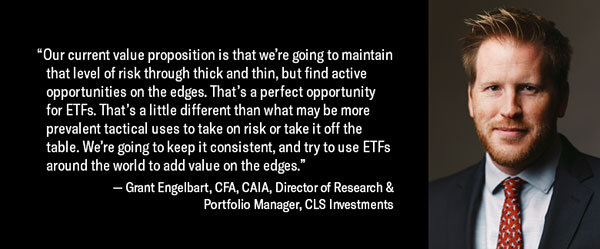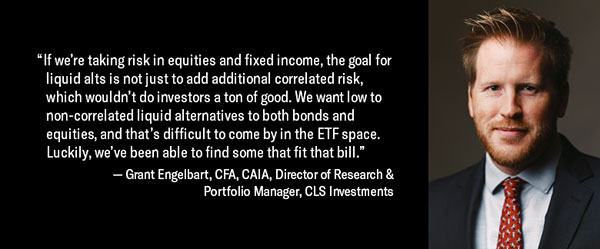This content is from:APP亚博娱乐
The Alternatives Alternative
Liquid alt ETFs help diversify portfolios in an uncorrelated way, with the upsides of tax efficiency, cost, and transparency that are hard to come by in the traditional alt space.

There’s an investment view that ETFs aren’t just tactical tools, but rather foundational to an allocation strategy. CLS Investments is a true believer in ETFs, and has been since the funds’ inception in the early 1990s. That position has put them “ahead of the game,” saysGrant Engelbart, CFA, CAIA, Director of Research & Portfolio Managerat the firm. Recently, Engelbart spoke to II about how CLS uses ETFs to a specific risk target for each portfolio.
Your firm was an early mover on using ETFs, dating back to the 1990s. What do you find so appealing about them in general?
We used to manage mutual fund of funds, and through the ‘90s we recognized that was a cost prohibitive pursuit with different layers of expenses. We started to incorporate some of the early ETFs into portfolios as a way to reduce costs and get that pure beta exposure into mutual fund of funds. By the time bond ETFs were launched in the early 2000s, along with individual country ETFs and the like, we had enough tools in the toolkit to build a full portfolio, or at least a somewhat diversified full portfolio. That’s when we started a separate account strategy of ETFs.

How has your use of them changed since then?
The universe has evolved to our offering a variety of different separate accounts in a lot of different areas, all focused on using ETFs as the underlying structure. And we’re very bullish on the future of ETFs, too, based on the experience we’ve seen so far and the huge benefits to investors.
What are those benefits?
Tax efficiency is huge, cost is huge, but also access. Every portfolio we manage has a specific risk target, and we’ve matched that with a client’s risk target. Our current value proposition is that we’re going to maintain that level of risk through thick and thin, but find active opportunities on the edges. That’s a perfect opportunity for ETFs. That’s a little different than what may be more prevalent tactical uses to take on risk or take it off the table. We’re going to keep it consistent, and try to use ETFs around the world to add value on the edges. For diversified global portfolios and mandates, we’re targeting closer to ACWI than we are to the S&P, so that’s a bit different as well. The use of a variety of different asset classes helps us maintain that risk profile without having to trade every day. We can maintain the client’s risk by using less correlated asset classes.
As you move along the risk spectrum, what type of ETFs are you incorporating into your strategy?
From small to large as far as assets, and unique to plain as far as what they’re targeting. In a general ETF-based portfolio, we’ll have maybe a smart beta core, let’s say in the U.S., and then we’ll add onto that to target areas that we prefer. So maybe we’ll have a value ETF and we’ll have a financials ETF, or something like that to get more granular on the edges. We’ll do that domestically, internationally, and then also in fixed income. So, I want an international ETF to maybe tilt toward value and then also maybe a single country or region that we like.
In fixed income, we’ll have some broad exposure to duration and then maybe we want to up or lower credit risk – or maybe one allocation to emerging market debt plus additional sectors in fixed income. We’re going to maintain core allocations, but also explore those edges. There’s another standard allocation that we have to alternatives. We use commodities and liquid alternatives as another sleeve of our portfolios to round it out, and help maintain risk, and hopefully add alpha on the edges.

Specifically, in regard to liquid alts, what role do you see ETFs playing?
If we’re taking risk in equities and fixed income, the goal for liquid alts is not just to add additional correlated risk, which wouldn’t do investors a ton of good. We want low to non-correlated liquid alternatives to both bonds and equities, and that’s difficult to come by in the ETF space. Luckily,we’ve been able to find some that fit that bill as an alternative source of alpha or alternative return premium generated from a liquid alternative position.
Do you anticipate increasing allocations of non-correlated assets like liquid alts?
We’re ahead of the game from that standpoint. We have about a 10% allocation across portfolios, which may not be Homeric, but it’s pretty sizable compared to where most investors are. We are looking at increasing that in portfolios that aren’t at that level, and potentially increase allocations beyond that overall. We’ve had this allocation for a while and do anticipate building on it. If returns are going to be lower going forward we need to find a different source besides just pure equity and pure income from fixed income or capital appreciation. Something like merger arbitrage is a great example. It’s uncorrelated and a unique source to the portfolios.
When you talk with investors, do you find that some of them have misconceptions or hesitations about liquid alt ETFs?
Yes, and there are misconceptions that alternatives returns should always be up and to the right – essentially, they should never go down, just slowly go higher. As a client looks at their portfolio and they see a particular position that’s lagging in a year, like this year where stocks and bonds are up, they ask questions, but the explanation doesn’t have to go far. You have a liquid alternative in your portfolio because it’s not correlated to stocks and bonds. If stocks and bonds are higher, than that liquid alt isn’t supposed to be up. If it is, then something’s wrong. And if it’s keeping pace with the stock and/or bond market, then something is probably not quite right about that product. We like to remind people of things like Q4 2018 when explaining why liquid alternatives are needed in a portfolio. So yes, there are misconceptions, but we always try to bring clients back to that full portfolio view and say, “We’re taking this amount of risk for you. We’re doing it in different ways, and we’re doing it in different ways so that we don’t exceed that risk on the downside in particular.”
There’s a fair amount of speculation and forecasting for prolonged heightened volatility on the horizon, and maybe more frequent peaks and valleys. How important could liquid alt ETFs be in that scenario?
One of the scenarios in particular that we’ve talked about seems a little less likely now, but it was kind of a hot topic in previous years, namely stocks falling because interest rates are rising quickly. In that case, your bond ballast of the portfolio isn’t going to help you out. That’s a situation where it makes a ton of sense to have alternatives that aren’t correlated to either, and are sourcing that return from somewhere else. Going forward, it could be fast falling equities and rates continuing to fall as well, which is why it’s important to have less correlation to equities. Volatility in general is going to eat away at higher risk asset classes to a certain extent, and anything that’s levered.
In the alternative space, sometimes products get lumped together, and we would be cautious of that and taking on too much leverage. We think about the lower risk alternatives, again, merger arbitrage and managed futures. The options on managed futures aren’t terrific in the ETF space, but if they don’t eat up a bunch of risk then we can have a side allocation there and still be in other areas that we find attractive.
TheIndexIQ MNA ETFaligns with the strategy we’ve been running since the early 2000s. As we screen the universe of merger arbitrage ETFs, that is the one that provides ample liquidity and mitigates downside participation. The correlation with equities and bonds I’m looking at right now is statistically insignificant, and yet still delivering positive returns in years like 2018. But we would like to see the space grow and we think it will. One thing we love about MNA is that we can go online any time and see exactly what’s going on inside our merger arb strategy – there’s nowhere to hide, and that degree of transparency isn’t available in alternatives from a non-liquid LP structure.
Learn more about liquid alt ETFs.
This article is for informational purposes only. Grant Engelbart, CFA, CAIA, and CLS Investments are solely responsible for the content of this article, which may not necessarily represent the opinions of New York Life Investments.
点击最新的基金的基金名称page, which includes, the prospectus, investment objectives, performance, risk, and other important information. Returns represent past performance which is no guarantee of future results. Current performance may be lower or higher. Investment return and principal value will fluctuate, and shares, when redeemed, may be worth more or less than their original cost. Visit nylinvestments.com/etfs for the most recent month-end performance.
About risk
There are risks involved with investing in any such products, including the possible loss of principal. Investors in the Funds should be willing to accept a high degree of volatility and the possibility of significant losses. Diversification cannot assure a profit or protect against loss in a declining market.
“纽约人寿投资”既是一种服务标记, and the common trade name, of the investment advisors affiliated with New York Life Insurance Company. IndexIQ® is the indirect wholly owned subsidiary of New York Life Investment Management Holdings LLC and serves as the advisor to the IndexIQ ETFs. ALPS Distributors, Inc. (ALPS) is the principal underwriter of the ETFs, and NYLIFE Distributors LLC is a distributor of the ETFs. NYLIFE Distributors LLC is located at 30 Hudson Street, Jersey City, NJ 07302. ALPS Distributors, Inc. is not affiliated with NYLIFE Distributors LLC. NYLIFE Distributors LLC is a Member FINRA/SIPC.
1839094
